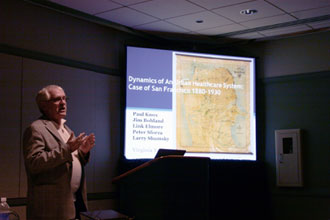AAG presentation on San Francisco health care system

Dynamics of an Urban Health Care System: Case of San Francisco 1880 to 1930
Research that leverages GIS in a unique way to visualize the changes in the spatial structure of San Francisco's health care system from 1880 to 1930 was presented at the 2011 Association of American Geographers Annual Meeting on April 15th. The presenters included Peter Sforza, director of CGIT Blacksburg; Link Elmore, CGIT graduate research assistant; and Jim Boland, senior fellow for biomedical, bioengineering, and health projects and executive director of the Northern Capital Region.
According to the abstract the study uses historic records and contemporary GIS methodologies to analyze the changing dynamics of physician location; allowing scientists to categorize physicians' practices and to track individual physicians and their offices through time. The full list of authors include: Paul Knox, Virginia Tech; Jim Bohland, Virginia Tech; Link Elmore, Virgina Tech; Peter Sforza, Virginia Tech; and Larry Shumsky, Virginia Tech.
A preview of the research results overlaid on historical video footage of Market Street in San Francisco just days before the 1906 earthquake and fire is available on Vimeo.
The full conference abstract:
Dynamics of an Urban Health Care System: Case of San Francisco 1880 to 1930
In the 19th century two significant and interdependent transformations - of the U.S. urban system and the medical care system – converged in ways that significantly influenced the subsequent spatial structure of health care providers in urban America. This paper uses these two transformations as the framework for examining changes in the spatial structure San Francisco's health care system from 1880 to 1930 by focusing on the dynamics of physician locations in the city. The study uses historic records and contemporary GIS methodologies to analyze the changing dynamics of physician location. The approach enables us to categorize physicians' practices and to track individual physicians and their offices through time. From our analysis two seemingly contradictory patterns emerge:–a) a dispersion of physicians during the period to newly emerging residential areas and b) a concentration of medical offices in the center city. These two trends differed in terms of the types of physician practices (for example, allopathic versus homeopathic); prior location (internal or external to the city); and medical degree location (San Francisco versus East Coast, for example). The medical transformative elements at play include a reduced number of practice types; greater reliance on scientific approaches; emergence of group practices; and class segmentation of patients by practice type. Relevant aspects of urban change included the expansion of public transport systems; new building technologies that enabled multi-storied medical arts buildings; ethnic diversity; rapid growth; and class segmentation.



